 |
Bethlehem Baptist Church
Organized in 1828. Chartered in 1838. Twice
burned and rebuilt. The present building was dedicated in 1921.
Photographed 2 Nov 2007 and Contributed by George Seitz. |
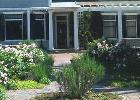 |
Bloemendaal In 1884 Lewis Ginter
built the Lakeside Wheel Club. In 1913 his niece, Grace Arents, bought the abandoned
building and added a second story, eventually making it her home. It is now part of the
Lewis Ginter botanical Garden.
Photographed May 2008 and Contributed by George Seitz. |
 |
Cheswick Built Circa 1796, it was
moved to it's present location on Three Chopt Road in 1972.
Photographed March 2001 and Contributed by George Seitz |
 |
Courtney Road Service Station The
square shape with a metal roof was popular in the mid-1920's. By 1938 the Barlow family
owned it. It closed in the 1960's.
Photographed Feburary 28, 2007 and Contributed by George Seitz |
 |
CSX shops (formerly RF&P) railroad
engine shops
Photographed 1995 and Contributed by Gill Pollard |
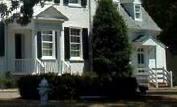 |
Dabb's House When General Joseph
Johnston was struck down at the Battle of Seven Pines, President Jefferson Davis
immediately replaced him with Robert E. Lee. Lee had no field command, nor headquarters.
The house at 3812 Nine Mile Road had been recently vacated by the widow Kate Dabbs. She
offered it to Lee, who accepted, his first headquarters as commander. The house, then
called High Meadow, was built in 1820. It served as Henrico's police headquarters from
1941-2005. Now it is a historic house museum with exhibit galleries and a research
library.
Photographed 3 July 2010 and Contributed by George Seitz. |
 |
Deep Run School Built in 1902 on
Three Chopt Rd. Moved in 1996
Photographed 3 Mar 2008 and Contributed by Paula Lucy Delosh |
 |
Deep Run School Historic Marker
Photographed 3 Mar 2008 and Contributed by Paula Lucy Delosh |
 |
Emmanuel Episcopal Church Consecrated by the Right Reverend John Johns on 6 July 1860, it is classic
late antebellum Gothic Revival architecture. Considerable military activity took place
near it during the Civil War, when troops from both sides occupied the church. Wounded
soldiers were treated there, and many Confederate soldiers lie buried in the cemetery.
Photographed 9 March 2007 and Contributed by George Seitz |
 |
Forest Lodge Copied from a 1910's
ad, it shows the Lodge which stood at the intersection of Mountain Road and the RF&P
railroad in Glen Allen, Henrico county. The luxury hotel was a stop for the wealthy on trips from
the northeast to Florida during the late 1800's and also a country escape for nearby Richmond.
Henrico county has part of the building on display near the original location. It was torn down in
the late 1980's.
Contributed by Gill Pollard |
 |
Forest Lodge What's left.
Photographed 4 Mar 2008 and Contributed by Paula Lucy Delosh |
 |
Forest Lodge Plaque on exterior.
Photographed 4 Mar 2008 and Contributed by Paula Lucy Delosh |
 |
Glen Allen Historic Marker
Photographed 3 Mar 2008 and Contributed by Paula Lucy Delosh |
 |
Glen Allen School In 1911 a
two-story brick building was opened to 100 pupils in seven grades, three teachers and a
principal. The school continued to grow and additions to the building were made in 1914
and 1919. It closed in 1978. In 1999 the renovated building was reopened as The Cultural
Arts Center of Glen Allen.
Contributed by George Seitz |
 |
Hopkins Cemetery, at Walkerton
Augustus Hopkins
Photographed 3 Mar 2008 and Contributed by Paula Lucy Delosh |
 |
Hopkins Cemetery, at Walkerton
Delia Hopkins
Photographed 3 Mar 2008 and Contributed by Paula Lucy Delosh |
 |
Hopkins Cemetery, at Walkerton
Fannie Hopkins
Photographed 3 Mar 2008 and Contributed by Paula Lucy Delosh |
 |
Hopkins Cemetery, at Walkerton
George Hopkins
Photographed 3 Mar 2008 and Contributed by Paula Lucy Delosh |
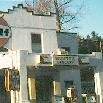 |
the store at Hunton Description The
village of Hunton was once a stop on the RF&P as well as a busy crossroads on the
Washington Highway.
Photographed 1995 and Contributed by Gill Pollard |
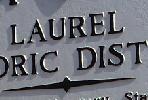 |
Laurel Historic District Historic
Marker
Photographed 3 Mar 2008 and Contributed by Paula Lucy Delosh |
 |
Laurel Industrial School
Established in 1890 as an alternative to
imprisonment for wayward boys. It was the first public school in the county. It is
listed on the National Register of Historic Places and the Virginia Historic
Landmarks Register.
Photographed 2 Nov 2007 and Contributed by George Seitz. |
 |
Locust Grove Farm also known as
the Nuckols Farm. Portions of the house predate Israel Nuckols's purchase in 1849. In the
far west end of the county, just off Broad Street.
Photographed 4 Mar 2008 and Contributed by Paula Lucy Delosh |
 |
Locust Grove Farm Separate
building on the farm.
Photographed 4 Mar 2008 and Contributed by Paula Lucy Delosh |
 |
Malvern Hill battle field At this
point the Union lines fired on the Confederate soldiers coming up from the valley in the
distance. This was part of the Seven Days Battles in 1862.
Photographed 1990 and Contributed by Gill Pollard |
 |
Mankin Mansion Built by Edward T.
Mankin in 1921. He established a
brickwork operation at this location that produced bricks for the Colonial
Williamsburg restoration project during the 1930s as well as the large residences
on Monument Ave, in Richmond. It is a National and State Registered Historic
Property.
Photographed 18 Dec 2007 and Contributed by George Seitz. |
 |
Mankin Gardener's Cottage One of
the surviving dependencies of Mankin
Mansion.
Photographed 18 Dec 2007 and Contributed by George Seitz. |
 |
Meadow Farm Listed in the
National Register of Historic Places, it was donated to Henrico County in 1975 by
Elizabeth Adam Crump, wife of the late Adjutant General of Virginia, Sheppard Crump. is.
It interprets Southern rural culture through living history, educational programs and
exhibitions.
Photographed Feburary 28, 2007 and Contributed by George Seitz |
 |
Nuckols Cemetery at Locust Grove
Farm
Photographed 4 Mar 2008 and Contributed by Paula Lucy Delosh |
 |
Clarke Palmore House Circa 1825,
the second story was added around 1855 and the rear addition about 1925. In 1855 it was
the home of Estelle Clarke Palmore and her husband John William Palmore. It was given to
the County of Henrico by Vera Palmore Morton and George Baskerville Morton in 1999. From
the hill at 904 McCoul Street there is a good view of Richmond, two and one half miles
distant to the west.
Photographed 30 Jul 2009 and Contributed by George Seitz. |
 |
Saint Joseph's Villa A Catholic
orphanage and school for girls, called St. Joseph's, was established in Richmond in 1834,
by 3 Sisters of Charity. They purchased the Hollybrook farm in Henrico in 1898. This is
the church on the current campus opened in 1931.
Photographed May 2008 and Contributed by George Seitz. |
 |
Shaw House Built about 1853.
Photographed 18 Dec 2007 and Contributed by George Seitz. |
 |
Skipwith Academy Lord Alfred
Bosson designed the English style mansion
for Admiral Grey Skipwith, Jr. in 1927. The walls are 14 inches thick. It has
sandstone mantels and a circular turret stairway with leaded stained glass
windows painted with medieval scenes.
Photographed 5 Nov 2007 and Contributed by George Seitz. |
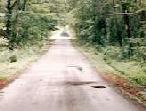 |
Telegraph Road The battle of Yellow
Tavern was fought on this part of what would later become US Route 1. The area
photographed is about where the food court is located in the Virginia Center Commons Mall.
It was barely wide enough for two cars to pass and the concrete one lane bridge over the
Chickahominy River still exists at the edge of the mall parking lot.
Photographed 1989 and Contributed by Gill Pollard |
 |
VA State Fair Sep 1999
Photographed and Contributed by Gill Pollard |
 |
Varina Episcopal Church
Constructed in 1926. This new parish was carvedfrom one of the most historic parishes in
American Anglicanism.
Photographed February, 2007 and Contributed by George Seitz |
 |
Virginia Randolph Cottage A
National and Virginia Historic Landmark. It
was the office of a black woman who gained national repute for promoting
innovative teaching methods. The cottage was built in 1937 and is now maintained
as a museum.
Photographed Oct 2007 and Contributed by George Seitz. |
 |
Walkerton constructed in 1825 for
John Walker, it has served as a tavern, hotel, store, voting precint and private dwelling.
It is the largest 19th century brick tavern still standing in the county.
Photographed Feburary 28, 2007 and Contributed by George Seitz |
 |
Walkerton Historic Marker
Photographed 3 Mar 2008 and Contributed by Paula Lucy Delosh |
 |
Whichello Circa 1827. It has also
been known as "Tall House," It is a
center hall frame structure with a five-bay facade and exterior end chimneys.
It is two full stories with a basement and finished loft. In it's early days
it was used as a tavern.
Photographed Oct 2007 and Contributed by George Seitz. |
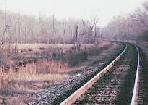 |
White Oak Swamp Looking east toward
the area of the 1862 battle area near Elko. Because of the swamp, the armies were funneled through
this area during the Federal retreat.
Photographed 1999 and Contributed by Gill Pollard |
 |
Willis Parsonage Ruins The
residence of the minister of Willis Church.
During the July 1, 1862 Battle of Malvern Hill it was directly in the line of
advance of Southern troops. It was plainly in sight of the Union Artillery.
It was destroyed by fire in 1988.
Photographed May 2008 and Contributed by George Seitz. |
![]() Henrico County Photo
Album Index
Henrico County Photo
Album Index